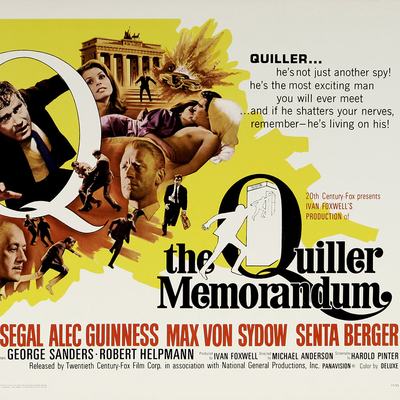


The middle of the 1960s was a spy's, spy's, spy's world, at least at the movies. The James Bond franchise was a phenomenon when it began with Dr. No (1962) and would produce almost a film a year until Sean Connery left the role for the first time after You Only Live Twice (1967). Cometh the hour, cometh the man – there was a hunger for secret agent stories among audiences, and the long upshift of gears from the '50s to the '60s was the right time for the spy hero, culturally, socially and (especially) politically.
The genre was hardly new; in the movies, it had begun in earnest with Fritz Lang and Spies (1928) in the silent era, and the director would continue to define its conventions with his Dr. Mabuse pictures before leaving for Hollywood. In Britain, Alfred Hitchcock's The Man Who Knew Too Much (1934), The 39 Steps (1935), Sabotage (1937) and The Lady Vanishes (1938) all contributed mightily to the nascent genre even before the director made his own move across the Atlantic.
World War Two was an excellent setting for spy stories, and films like Lang's Hangmen Also Die (1943) and Ministry of Fear (1944), Carol Reed's Night Train to Munich (1940) and The Third Man (1949), The Mask of Dimitrios (1944), I See a Dark Stranger (1946), 13 Rue Madeleine (1947), Decision Before Dawn (1951) and The Man Who Never Was (1956). Hitchcock would return to the genre with Notorious (1946), his remake of The Man Who Knew Too Much in 1956, North by Northwest (1959), Torn Curtain (1966) and Topaz (1969).
James Bond and the Cold War opened up the landscape considerably for the espionage film. The spy spoof and other campy variations took form with Dean Martin's Matt Helm and James Coburn's Derek Flint, and an explosion of titles from either side of the Atlantic – films like That Man from Rio (1964), Modesty Blaise (1966), Kiss the Girls and Make Them Die (1966) and Deadlier than the Male (1967). Doris Day even entered the game with Caprice (1967). On television there was The Man from U.N.C.L.E., Mission Impossible and I Spy in the U.S., and Danger Man, The Saint and The Avengers in the UK.
There was also a far less campy province of the genre, with British producers making films from British spy novels. Their downbeat tone had been set by Graham Greene (Ministry of Fear, Our Man in Havana, The Quiet American) and embodied in John le Carre's books, starting with Martin Ritt's adaptation of The Spy Who Came in From the Cold (1965). The same year saw Michael Caine debut as Harry Palmer in The Ipcress File, based on a book in Len Deighton's series of novels featuring the spiv-turned-spy.
The Quiller Memorandum should fit neatly into this genre. Released a year later, it was also based on a British spy novel – The Berlin Memorandum, published in 1965 by the pseudonymous Adam Hall, also know as Elleston Trevor (real name Trevor Dudley-Smith, who had his short story made into the film The Flight of the Phoenix a year earlier.) It was set in the same dank, rundown, morally ambiguous world as le Carre and Deighton's novels, in a British secret service establishment run by titled toffs and former public schoolboys.
Michael Anderson's movie adaptation should probably have fit neatly into that world. But for mysterious reasons the film's producers decided to recast Hall's Quiller – an MI6 agent, veteran of wartime spy agencies like the SIS or the SOE and master of several obscure martial arts – as an American, though still in the employ of The Bureau, a shadowy but still very British espionage agency tasked with rooting out Nazis and neo-Nazis in postwar Germany.
The film starts with a classic spy movie opener: a man in a sharp suit walks warily along a deserted street late at night. John Barry's score introduces the sound of a zither, evoking Anton Karas and The Third Man. The man attempts to get help to shake off whomever is tailing him by ducking into a phone booth, but a shot rings out and he collapses, now the dead man necessary to spell out the stakes of the game that will follow.
Cut to the Queen's Foot Guards parading down The Mall, and a nearby private club in St. James where Gibbs (George Sanders) and Rushington (Robert Flemyng), two of those toffs and ageing public schoolboys, discuss some frightfully bad business in Berlin over lunch – an agent shot by a sniper, needs looking into, I assume you're sending your man Quiller, jolly good, how's your pheasant? So far, no surprises.
Back to Berlin, and probably the most Berlin-y location next to the Reichstag ruins or the Brandenburg Gate: Werner March's 1936 Olympic Stadium. Quiller (George Segal) walks past a tour group to meet Pol (Alec Guinness), the handler from The Bureau who summoned him back from his vacation and his preferred Middle Eastern locales to look into the killing of not one but two operatives, the last (of course) an old friend of Quiller's.
Pol points to the empty VIP stands in the stadium and mentions "certain well-known personalities who used to stand right there" as a way of introducing their opponents: "Nazis from top to toe – in the classic tradition." Quiller takes the job – he has no choice, of course – but adds that he prefers to work alone, without handlers or protection, even if working the same way got his friend killed.
I haven't been able to find out why George Segal was cast as Quiller, and then apparently only after Charlton Heston (!!!) turned down the part. Segal was a strange choice, probably stranger than Heston; his Quiller is very American, apparently (but not really) unable to speak German and given to endless obtuse banter with each Berliner he meets, prattling on about Philadelphia or swimmers or boxing. He's trying – perhaps a little too hard – to get the enemy to underestimate him.
Segal's casting was certainly against type. He had a peculiar kind of persona, and one that seemed out of place in the half dozen or so films he appeared in until Who's Afraid of Virginia Woolf?, released the same year as The Quiller Memorandum. He's less stoic and manly than antsy, sarcastic and neurotic – the beta version (no pun intended – or is it?) of actors like Elliott Gould, Richard Dreyfuss, Donald Sutherland and Dustin Hoffman who'd arrive onscreen in his wake.
Segal's Quiller decides that the best way to flush out the enemy is to let them know he's there, which involves making himself conspicuous as he follows the trail of meagre clues left behind by his colleague – a search that leads from a bowling alley to a public swimming pool to a school where a teacher had recently been fired after he was exposed as a Nazi.
He meets a pretty young teacher, Inge (Senta Berger), and pursues what appears to be a mutual attraction. After he leaves her apartment he confronts a trio of men following him, revealing himself to speak fluent German. Back at his hotel a bellboy bumps into him with a suitcase, before Quiller speeds off into traffic, trying to lose Hengel (Peter Carsten) his tail from The Bureau, after which he becomes delirious, drugged by whatever was injected into him by the suitcase at the hotel.
Quiller wakes up in the cavernous basement of a dilapidated mansion, the guest of Oktober (Max von Sydow), the head of the neo-Nazi underground. He tries to escape but, eschewing a firearm and far less skilled at martial arts than his character in the books, he ends up beaten and drugged while Oktober inflicts a rambling, baffling interrogation on him that invokes The Manchurian Candidate.
Quiller tries to resist and give up as little information as possible, choosing to babble about Inge; Oktober tries to discourage him from this subject before fervidly telling a delirious Quiller that she loves him and that his reward for talking will be returning to her. He then abruptly loses interest and the next scene begins with Quiller waking up in the moonlight on a half-submerged dock in the River Spree. He steals a cab and loses his pursuers before wandering, filthy, soaked and shoeless, into a sketchy hotel, ordering a room and a new pair of shoes from the concierge.
The world Anderson and screenwriter Harold Pinter create in The Quiller Memorandum is a strange but vivid one. When the film was released it had been five years since the Berlin Wall was erected, four since the Cuban Missile Crisis and three since Kim Philby had defected to the Soviet Union. The Cold War would get hotter, but it was definitely far from cool.
And yet nowhere in the film do we see the Wall, pass through Checkpoint Charlie or travel into East Berlin. At no point does any character mention East Germany or the Soviet Union, the Stasi or the KGB. It's as if The Quiller Memorandum is set in an alternate reality where General Zhukov's troops never crossed the Oder, leaving the Western Allies solely in charge of reviving a Germany thickly populated with Nazi ghosts and their golems.
The only war we see in the film is between The Bureau and Oktober's neo-Nazi underground, and their sole objective is to discover, infiltrate and destroy each other's headquarters. The plan – and Quiller's role in it – is laid out by Pol on the tablecloth of a café, with two muffins and a raisin used to demonstrate how the agent is supposed to discover the enemy's hideout without giving away the location of their own.
It can't be accidental that neither Guinness nor Segal can hide their disappointment with this childlike strategy, and Harold Pinter was far too skilled a writer to imagine the audience wouldn't share in their puzzled dismay. Guinness certainly can't suppress a wry flash in his eyes when he pops the raisin representing Quiller into his mouth.
He might even have recalled this scene when, a decade later, he signed on to a low budget sci-fi film whose script he couldn't abide: "If I could sell that scene in the Quiller film, I can certainly put over this Obi-wan character."
Writing about the film on the Trailers from Hell website, Glenn Erikson says that "the only logic-hole I can see is the representation of the strength of the Neo-Nazi camp. The English spies can presumably use their own forces, the West German authorities and an army to root out and arrest any Nazis they might find. The Nazis can't even operate in the open. If Quiller told them where Pol's HQ is, what would they do? Any terror attack would reveal themselves even more."
Erikson is assuming that the world of the film is actually our own, and I'm not so sure it was ever meant to be. It's a horror film as much as a spy film, where the terror doesn't come from fear of death as much as loneliness and isolation in a place where the horrors of the recent past were never really defeated.
"The enemy chaperones that follow him are a flash mob of Neo-Nazi loiterers that don't even need to speak to each other," Erikson writes. "It's the Night of the Living Spy Dead."
"The effect is that all West Germans appear to be nefarious villains. Waiters, a hotel manager, a public pool manager, a man running a bowling alley – all seem part of the Neo-Nazi conspiracy. The more polite and patronizing they are the more paranoid we feel. Quiller can't take anybody at face value, not Inge's charming supervisor (Edith Schneider) nor Hengel, a supposed ally who nevertheless has villain written all over his thug face."
The Quiller Memorandum wasn't the only spy story where the enemy was a covert or resurgent Nazi menace. The Odessa File, a 1974 film based on Frederick Forsyth's 1972 novel, is another story about a hidden network of Nazis, taking sides in war in the Middle East. The Marathon Man (1976) was a story about a fugitive Nazi war criminal, and The Sum of all Fears (2002) infamously changed the Arab nationalists in Tom Clancy's original novel into nuke-smuggling neo-Nazis.
Rumours of real-life Nazi revivals have rarely matched their publicity. As Erikson points out, even a hint of neo-Nazi activity in West Germany would have been harshly suppressed, while in East Germany the totalitarian state's expressly anti-fascist constitution competed with its western neighbour in how ruthlessly it could root out Nazi sympathizers (while, of course, running a police state the Nazis would have envied.)
In Canada in the '80s we constantly read news stories about a neo-Nazi underground, centred around repellent figures like Ernst Zundel and Paul Fromm, and aided by a growing army of neo-Nazi skinheads. Having seen these Nazi skins up close in my hometown's punk scene, I already knew that they were a) remarkably stupid, b) small in number and generally despised, and c) easily driven from the streets of Kensington Market by punk vigilantes centred around a band called Bunchofuckingoofs.
Ultimately it turned out that Canada's Nazi underground was so heavily infiltrated by plants and agents from multiple police and national security agencies that it was never possible to accurately measure their actual numbers. Similarly, when Germany tried to outlaw the NPD in 2003 – one of the few neofascist parties that hadn't already been banned outright by the state – they discovered that material cited in proceedings had often been written by informers and agents within the party leadership.
In The Quiller Memorandum, von Sydow's reichsfuhrer is a pretty campy villain, but it's his zombie army of agents – potentially anyone Quiller has met since he arrived in Berlin – who appear truly scary, especially in the film's big showcase scene. Quiller discovers the Nazi headquarters thanks to Inge's boss and the swimming pool attendant, but finds that Oktober is one step ahead of him, capturing Inge and promising to kill her if he doesn't return with the location of The Bureau's base by the morning.
The agent has to get to a phone, but every attempt is thwarted by another Nazi zombie emerging from the shadows; even the payphone in his dive hotel has been sabotaged. Every feint at spy tradecraft is thwarted, as more of Oktober's silent minions shadow him around the city. He finally evades them by repurposing a car bomb meant to finish him off (don't look for logic; it's all about mood) and arrives at Pol's headquarters on an empty floor of the just-finished Europa-Center, under the big Mercedes-Benz logo, just in time to call in the authorities.
They round up the whole gang – everybody but the girl, who Quiller finds back in class the next day, telling him a story about how Oktober had, mysteriously, just let her go. And that's where he leaves her, along with her boss, who seems shocked to see him; both women in charge of hundreds of German children while Quiller walks, alone, into the distance away from the camera. As a spy movie ending, it's less Thunderball (released just a year before) and more Invasion of the Body Snatchers.
Mark Steyn Club members can let Rick know what they think by logging in and sharing in the comments below, as access to the comments section is one of many benefits that comes along with membership in the Mark Steyn Club.
